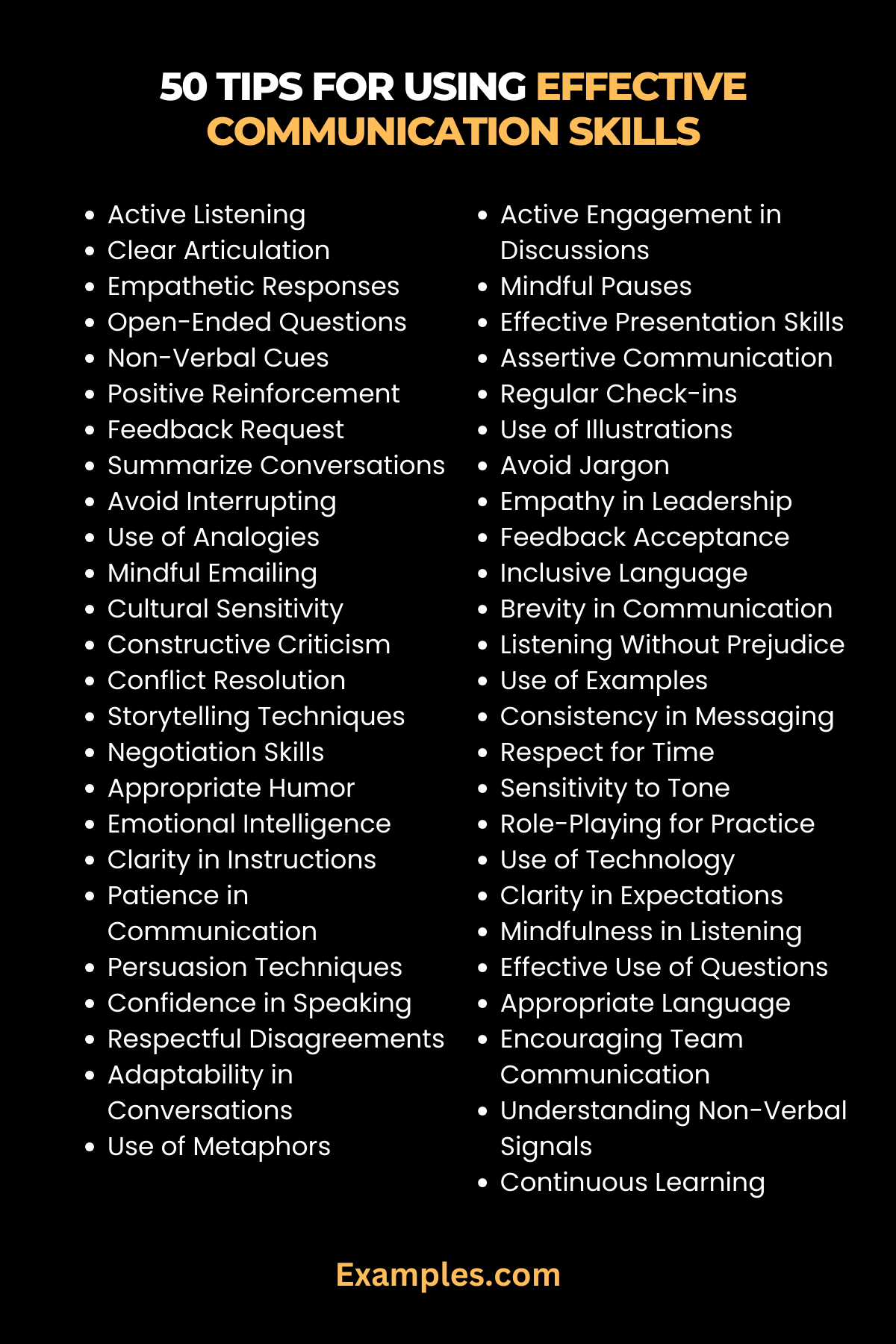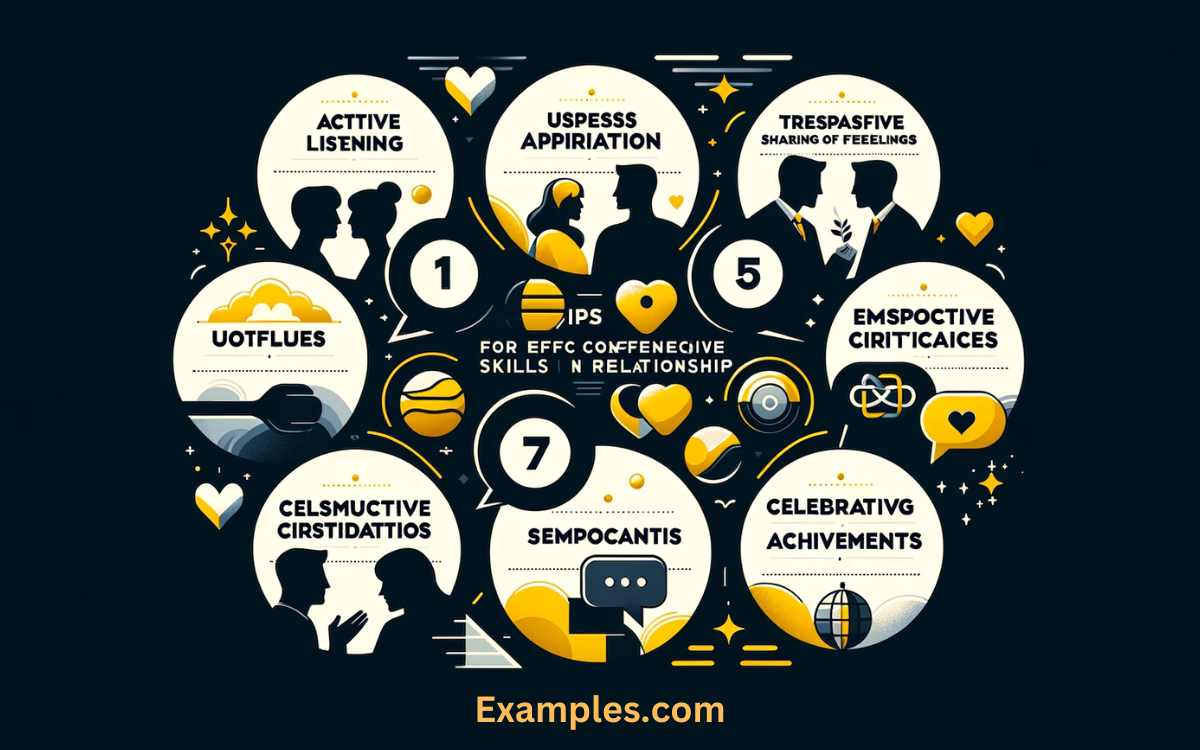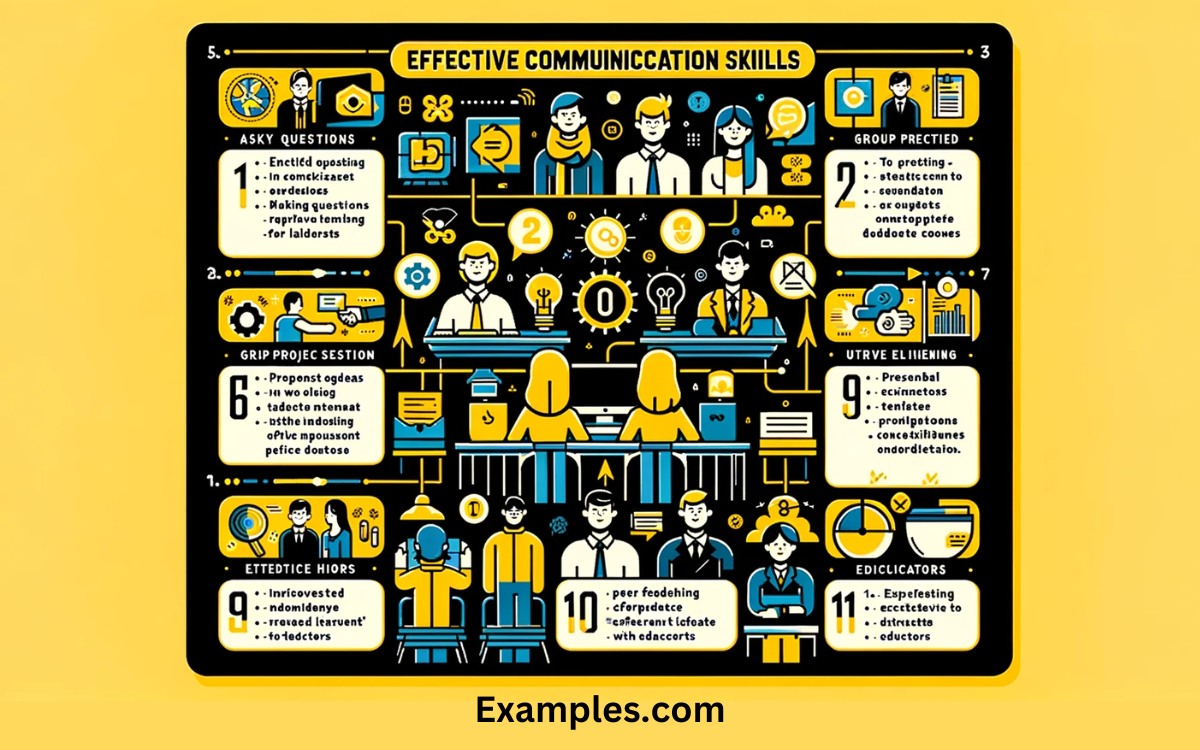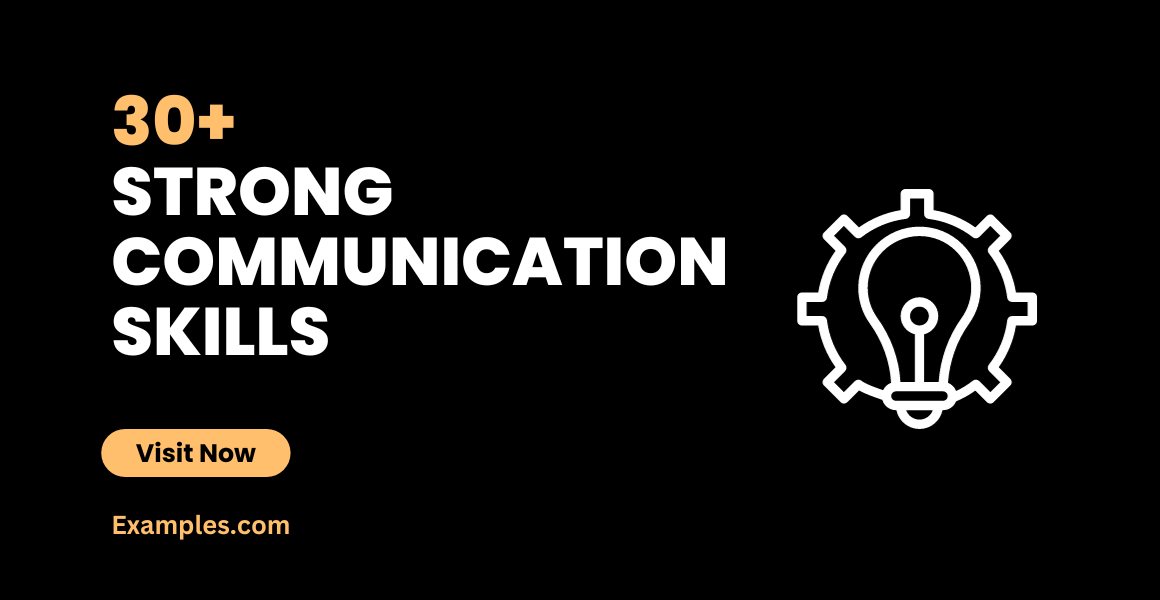Tips for Effective Communication Skills – 49+ Examples, Tips
Welcome to our complete guide on “Tips for Effective Communication Skills,” where we delve into the art of impactful interaction. In this resource, you’ll discover a variety of practical tips accompanied by Communication Examples to help you understand and apply these skills effectively. Whether you’re a professional, student, or simply seeking to enhance your interpersonal abilities, our guide is tailored to offer insightful strategies that cater to diverse communication needs in various settings. Let’s embark on this journey to master the art of effective communication together!
50 Tips for Using Effective Communication Skills
Effective communication skills are essential in all aspects of life. They enhance relationships, boost workplace productivity, and improve understanding in various social interactions. This guide offers 50 unique and practical tips for effective communication, each accompanied by an example and a brief explanation. By incorporating these tips, individuals can develop strong communication skills that are crucial for success in personal and professional settings.

- Active Listening: Show genuine interest in the conversation.
Example: Nod and maintain eye contact to demonstrate engagement. - Clear Articulation: Speak clearly without mumbling.
Example: Practice enunciating words in a mirror to improve clarity. - Empathetic Responses: Understand and reflect feelings.
Example: Say “I understand that must be tough for you,” to show empathy. - Open-Ended Questions: Encourage detailed responses.
Example: Ask “What are your thoughts on this topic?” - Non-Verbal Cues: Use body language effectively.
Example: Lean forward slightly to show you’re attentive. - Positive Reinforcement: Offer praise and encouragement.
Example: Say “Great job on that presentation!” to motivate. - Feedback Request: Seek opinions on your communication.
Example: Ask “How can I explain this better?” - Summarize Conversations: Ensure mutual understanding.
Example: Recap main points at the end of a meeting. - Avoid Interrupting: Let others finish speaking.
Example: Pause before responding to ensure they’re done talking. - Use of Analogies: Simplify complex ideas.
Example: Compare a business concept to a well-known story for clarity. - Mindful Emailing: Be concise and clear in emails.
Example: Reread emails for tone and content before sending. - Cultural Sensitivity: Respect diverse backgrounds.
Example: Be aware of cultural norms in international settings. - Constructive Criticism: Offer feedback kindly.
Example: Frame suggestions as opportunities for improvement. - Conflict Resolution: Address issues directly.
Example: Discuss disagreements calmly to find solutions. - Storytelling Techniques: Engage listeners with stories.
Example: Use personal anecdotes to illustrate points. - Negotiation Skills: Aim for win-win situations.
Example: Find common ground in business negotiations. - Appropriate Humor: Lighten the mood when suitable.
Example: Share a relevant joke to ease tension. - Emotional Intelligence: Manage your emotions.
Example: Take deep breaths when feeling overwhelmed. - Clarity in Instructions: Give clear directions.
Example: Use simple, direct language when delegating tasks. - Patience in Communication: Allow time for understanding.
Example: Repeat points if necessary, without frustration. - Persuasion Techniques: Influence with logic and emotion.
Example: Use facts and storytelling in sales pitches. - Confidence in Speaking: Project assurance.
Example: Stand tall and speak with conviction in meetings. - Respectful Disagreements: Disagree without being disagreeable.
Example: Use “I understand, but…” to express differing views. - Adaptability in Conversations: Adjust to the listener’s style.
Example: Be more formal with superiors, relaxed with peers. - Use of Metaphors: Enhance understanding with metaphors.
Example: Describe a complex process as a journey. - Active Engagement in Discussions: Participate actively.
Example: Contribute ideas in team brainstorming sessions. - Mindful Pauses: Use pauses for emphasis.
Example: Pause after key points to allow them to sink in. - Effective Presentation Skills: Deliver engaging presentations.
Example: Use visuals and stories to captivate the audience. - Assertive Communication: Express needs respectfully.
Example: State your opinion firmly yet politely. - Regular Check-ins: Maintain communication flow.
Example: Schedule weekly meetings to stay updated. - Use of Illustrations: Visual aids in explanations.
Example: Use diagrams to explain complex concepts. - Avoid Jargon: Use simple language.
Example: Replace technical terms with everyday language when possible. - Empathy in Leadership: Understand team emotions.
Example: Ask team members about their well-being. - Feedback Acceptance: Be open to receiving feedback.
Example: Thank for feedback and reflect on it. - Inclusive Language: Include everyone in conversations.
Example: Use “we” instead of “I” in team discussions. - Brevity in Communication: Be concise yet thorough.
Example: Deliver messages in a few well-chosen words. - Listening Without Prejudice: Avoid assumptions.
Example: Listen fully before forming opinions. - Use of Examples: Clarify with real-life examples.
Example: Illustrate a point with a relevant case study. - Consistency in Messaging: Stay consistent in communication.
Example: Align verbal and written messages. - Respect for Time: Be punctual in responses.
Example: Reply to emails and calls in a timely manner. - Sensitivity to Tone: Be aware of how you sound.
Example: Use a friendly tone in customer service interactions. - Role-Playing for Practice: Enhance skills through practice.
Example: Simulate difficult conversations for preparation. - Use of Technology: Leverage digital communication tools.
Example: Use video conferencing for remote meetings. - Clarity in Expectations: Set clear expectations.
Example: Clearly outline project goals and deadlines. - Mindfulness in Listening: Be fully present when listening.
Example: Avoid distractions during conversations. - Effective Use of Questions: Probe for deeper understanding.
Example: Ask follow-up questions to gain more insight. - Appropriate Language: Match language to the audience.
Example: Use professional language in business settings. - Encouraging Team Communication: Foster open dialogue.
Example: Create a safe space for team feedback. - Understanding Non-Verbal Signals: Read body language.
Example: Observe facial expressions for unspoken cues. - Continuous Learning: Keep improving communication skills.
Example: Attend workshops and read relevant books.
Tips for Effective Communication Skills in the Workplace
Effective communication in the workplace is vital for teamwork, productivity, and maintaining a positive work environment. Mastering communication skills at workplace ensures that ideas are shared clearly and collaborations are successful. Incorporating these skills leads to better project management, conflict resolution, and employee satisfaction. Here are ten distinct examples to enhance your workplace communication skills.

- Prioritizing Clarity in Emails: Write emails with clear, concise language.
Example: Use bullet points to highlight key tasks in email instructions, ensuring easy understanding and follow-up. - Regular Team Meetings: Conduct consistent meetings to discuss progress.
Example: Organize weekly team meetings to review project updates, fostering a culture of open communication. - Constructive Feedback Culture: Foster an environment where feedback is welcomed.
Example: Encourage employees to provide regular feedback on processes, promoting continuous improvement. - Effective Use of Digital Tools: Utilize technology for better communication.
Example: Implement project management software for streamlined communication and task tracking. - Respectful Listening During Conflicts: Actively listen during disagreements.
Example: In conflicts, focus on understanding the other person’s perspective without interrupting, promoting resolution. - Clear Communication of Goals: Define and communicate objectives clearly.
Example: At the start of a project, clearly outline goals and expectations to the team to ensure alignment. - Acknowledging Contributions: Recognize and appreciate team efforts.
Example: Publicly acknowledge individual achievements in meetings, enhancing team morale. - Adapting Communication Styles: Tailor your communication to diverse team members.
Example: Use more detailed explanations with team members who prefer in-depth discussions. - Encouraging Open Dialogue: Create an environment where opinions are valued.
Example: Host regular brainstorming sessions where all team members are encouraged to share ideas. - Timely and Effective Feedback: Provide constructive feedback promptly.
Example: Offer immediate, specific feedback after presentations, aiding in rapid skill development.
Tips for Effective Communication Skills in a Relationship
Effective communication is the cornerstone of healthy and lasting relationships. Mastering communication skills in relationships fosters understanding, trust, and deeper emotional connections. Embracing these skills can transform interactions, resolving conflicts and enhancing mutual respect. This guide offers ten unique examples, each with a brief explanation, to improve communication skills for couples.

- Active Listening in Conversations: Pay full attention to your partner.
Example: During discussions, put away distractions like phones to show you’re fully engaged. - Expressing Appreciation Regularly: Show gratitude often.
Example: Say “I appreciate you doing…” to acknowledge your partner’s efforts and strengthen the bond. - Transparent Sharing of Feelings: Be open about emotions.
Example: Communicate feelings honestly, like saying “I feel happy when…” to foster emotional intimacy. - Using ‘I’ Statements in Conflicts: Avoid blame.
Example: Say “I feel upset when…” instead of “You make me upset,” to express feelings without accusing. - Regular Relationship Check-ins: Discuss the health of your relationship.
Example: Schedule monthly conversations to share feelings and address concerns, keeping the relationship strong. - Respecting Boundaries: Understand and honor each other’s limits.
Example: Ask your partner’s comfort level with certain topics or situations, respecting their boundaries. - Positive Body Language: Use affirming non-verbal cues.
Example: Maintain eye contact and nod during conversations to show you are attentive and caring. - Constructive Criticism: Offer feedback kindly.
Example: Frame suggestions as ways to grow together, such as “We could try…” instead of pointing out faults. - Empathetic Responses: Show genuine understanding.
Example: Respond with “That sounds really challenging,” to validate your partner’s feelings. - Celebrating Achievements Together: Share in each other’s successes.
Example: Congratulate your partner on their accomplishments, showing support and shared joy.
Tips for Effective Communication Skills for Students
Effective communication is a crucial skill for students, aiding in academic success and interpersonal relationships. Enhancing communication skills for students leads to better group work, clearer presentations, and improved teacher-student interactions. This guide provides ten unique examples to help students communicate more effectively, fostering an environment of collaboration and mutual understanding.

- Asking Questions in Class: Don’t hesitate to seek clarification.
Example: If a concept is unclear, politely ask the teacher, “Could you please explain this part again?” - Group Project Coordination: Share ideas and listen.
Example: During group discussions, contribute your thoughts and acknowledge others’ ideas, promoting teamwork. - Email Etiquette with Teachers: Write respectfully and clearly.
Example: Start emails with a greeting, briefly state your query, and end with a thank you. - Participating in Classroom Discussions: Engage actively in topics.
Example: Share your insights on the subject matter, adding depth to class conversations. - Presenting Ideas Confidently: Practice public speaking.
Example: Rehearse your presentation to deliver it confidently and engage your audience effectively. - Peer Feedback Sessions: Give and receive constructive feedback.
Example: Offer specific, positive feedback to classmates, like, “I really liked how you explained that concept.” - Active Listening to Lectures: Focus intently on lectures.
Example: Take notes and avoid distractions to fully absorb the lecture content. - Resolving Conflicts with Peers: Approach issues calmly.
Example: Address misunderstandings with classmates by discussing them openly and respectfully. - Utilizing Office Hours Effectively: Make the most of one-on-one time with teachers.
Example: Prepare questions in advance to discuss during office hours for better understanding. - Expressing Gratitude to Educators: Show appreciation for their efforts.
Example: Thank educators for their guidance, reinforcing a positive student-teacher relationship.



